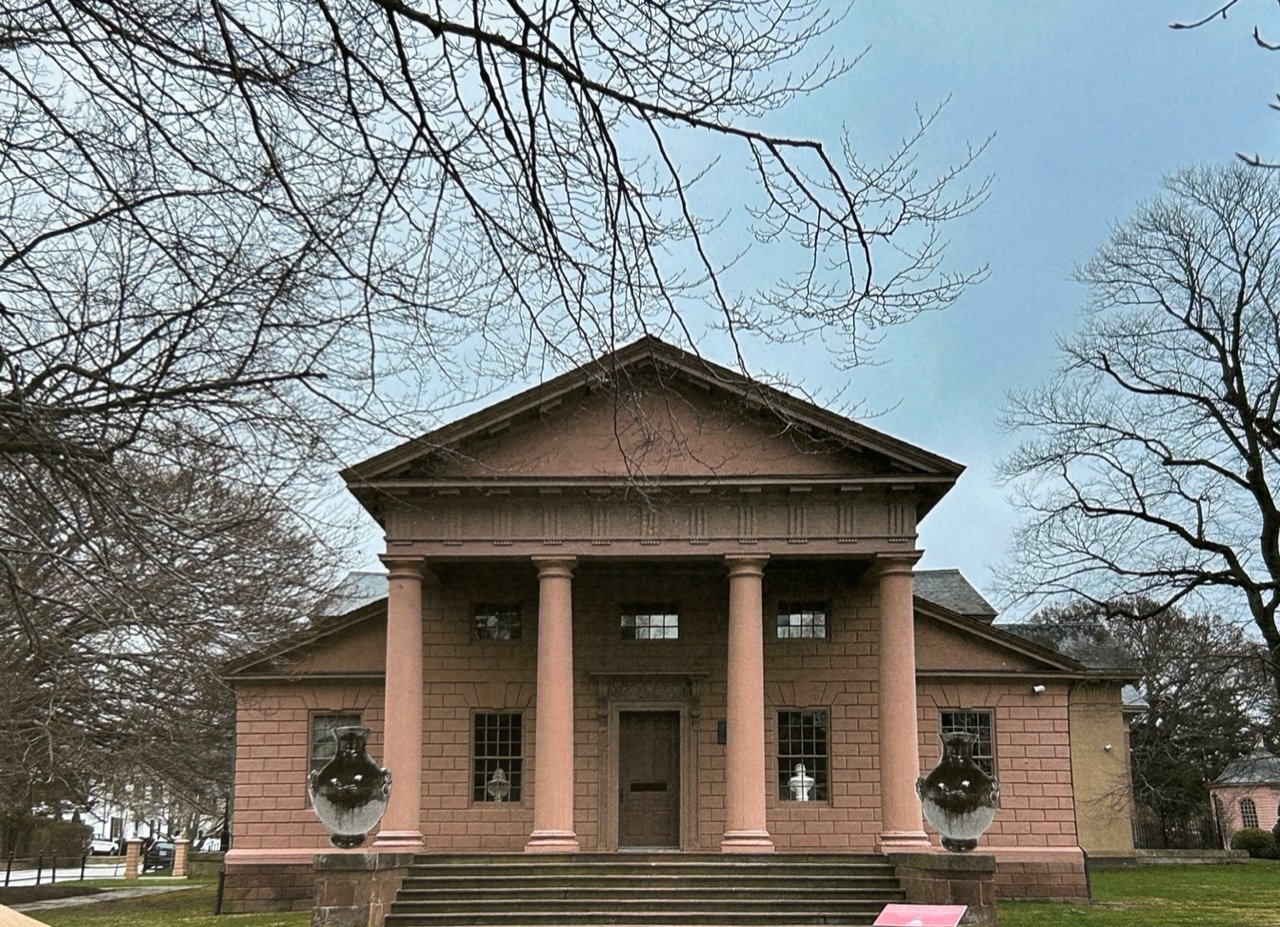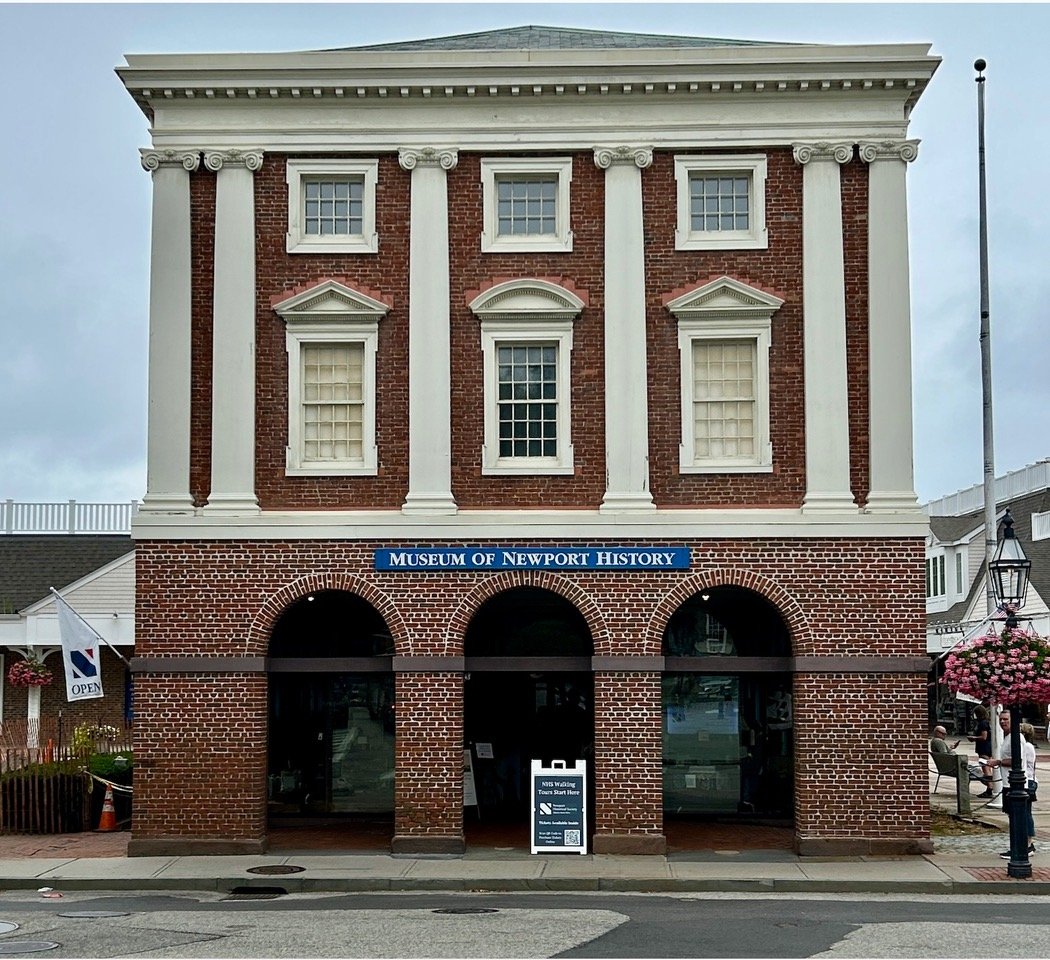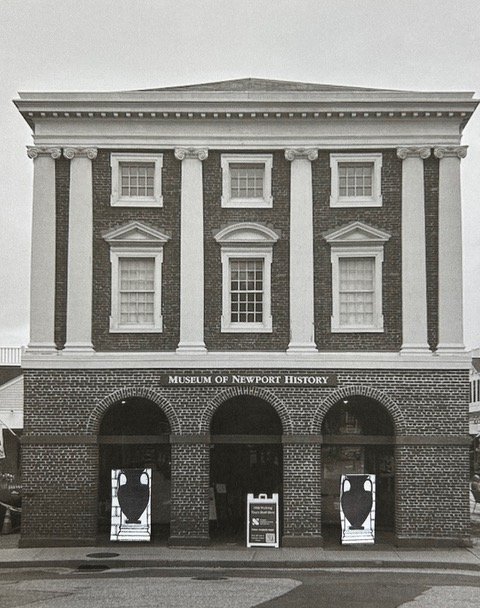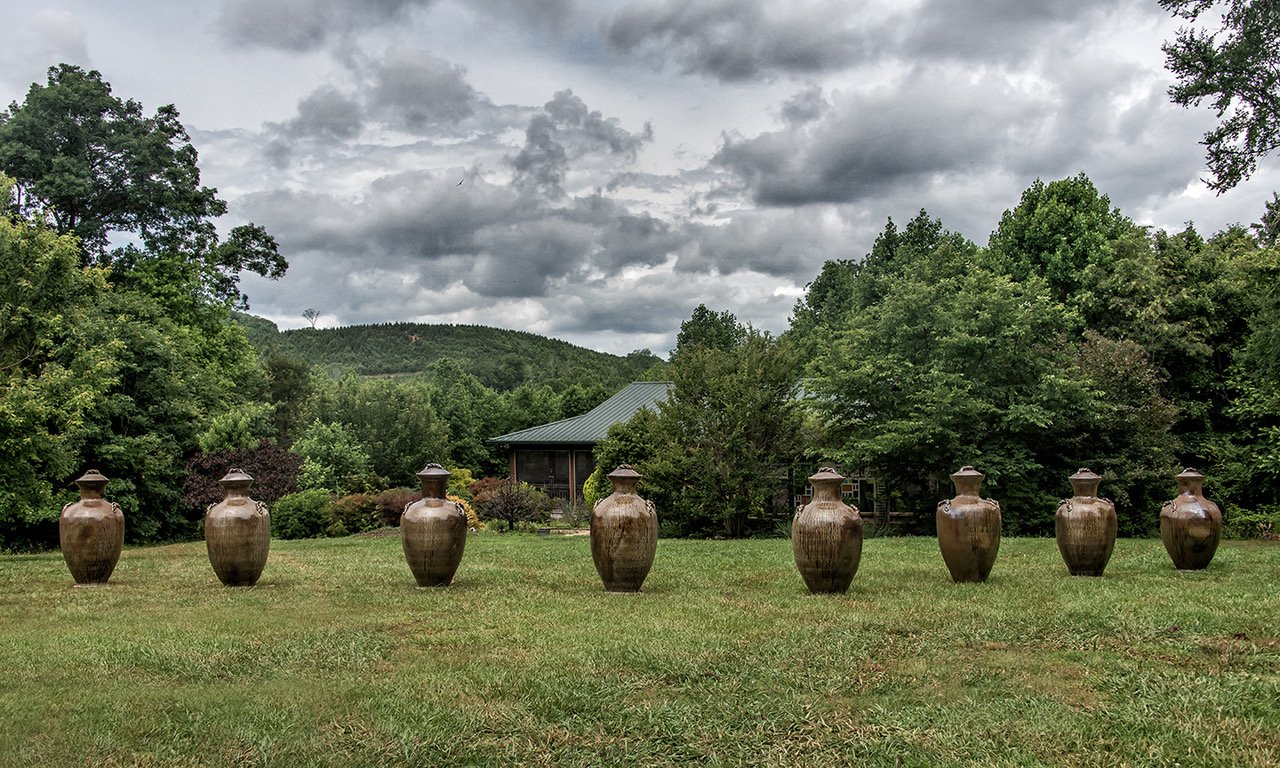The Newport Amphora Project
The Redwood Library and Athenaeum, The Touro Synagogue and The Newport Historical Society - Newport, RI
June - October, 2026
The Newport Amphora Project
Founded in 1639, with the policy of liberty of conscience and freedom of religion written into the town statutes of 1641, Newport, Rhode Island was an immediate home to a rich diversity of religions and beliefs. People in search of these freedoms and opportunities moved to Newport from other more puritanical colonies, as well as from other countries. The city grew quickly and became a major colonial shipping port by the time of Peter Harrison’s arrival as a ship captain and architect in 1740.
This project is focused on Peter Harrison, Architect (1716 -1775) and the three extant architectural landmarks he designed in Newport: The Redwood Library and Athenaeum (Built between 1748 and 1750); The Touro Synagogue (Built between 1759 and 1763); and The Brick Market Building (Built between 1762 and 1772). Also included will be the garden pavilion from Abraham Redwood’s Summer House originally built in Portsmouth, RI (1766) and moved to the Redwood’s gardens in 1917.
The Company of the Redwood Library was established in 1747 by Abraham Redwood and 45 fellow colonists with the goal of (to) “Propagate virtue, knowledge, and useful learning with nothing in view but the good of mankind”. The building was the first purposely built library in the United States, and is the oldest neo-Classical building in the country. It has been in continuous use since its opening.
The first 15 Jewish families arrived in Newport in 1658 from the Caribbean. Originally Spanish and Portuguese “Converso” Jews who were forced from their homes during the Inquisition, they made their way to Amsterdam, then the Dutch Caribbean colonies and finally to Newport. The land for the Jewish cemetery was purchased in 1677, on what became known as “Jew Street” (before being renamed Bellevue Avenue). Less than 100 years later the Jewish community of Newport was large enough and prosperous enough to build the Touro synagogue.
The Brick Market Building was commissioned by the city of Newport and built on a port side wharf. It originally functioned as an open-air market on the ground floor, with offices on the upper floors. It is still owned by the city, but is now managed and programmed by the Newport Historical Society as The Museum of Newport History.
The Intellectual (Library / Athenaeum), The Spiritual (Synagogue) and The Commercial (Market Building).
The idea that each of these three fundamental human pursuits is housed in a building designed by the same architect, around the same time and within walking distance from each other is fascinating and brings up many interesting questions and issues. Harrison's use of the classical architectural language in a radically new temporal, geographic and cultural context also offers a lot to think about.
I spent about 15 months doing research before figuring out what I wanted to make for this project. The bibliography included at the end of this document offers a window into the research done, and some of the areas of particular interest were:
The formal architectural language and design of each building, their similarities and differences, and how architecture was used to convey meaning and legitimacy for each institutional occupant; the key people and families involved in the founding, financing and management of these three institutions (some of the same people were involved in all three); the important industries that helped create the wealth of Newport, and that financed these buildings and institutions; Newport’s role in the abuse and displacement of the local indigenous people, as well as its role in the African slave trade and the practice of slavery.
There is a very rich convergence of ideas, aspirations and issues that existed in Newport in the Mid-18th Century. Colonialism, immigration, assimilation, enlightenment, religious freedom and tolerance, the separation of church and state, economic and societal opportunity, entrepreneurism, revolution and the birth of a democracy. And in the face of all of this openness of thought and belief, existed the hypocritical presence of the darker side of humanity in the forms of indigenous peoples oppression, exploitation and enslavement, as well as the many local industries built around the shipping, trading and employment of enslaved people from Africa. Together these pursuits played a significant role in building the city’s early wealth and infrastructure, as well as helping to fund its institutions. For better and worse, this period in Newport offers a true microcosm of the early early American story.
Ultimately thoughts about symmetry versus asymmetry have become the dominant theme of this project. It began with acknowledging the obvious, and for Peter Harrison unusual, asymmetry of the Touro Synagogue. This specific, formal, asymmetry was created by the addition of a side wing to the main building, which was mandated by the need for a children’s school room and a separate women’s entrance (the congregation was, and still is, orthodox). The building subtly draws additional attention to itself by being shifted off of the city grid so that the torah arc faces Jerusalem. These two distinguishing feature of the Touro struck me as a nice, architectural metaphor for the Jewish American experience…sort of fitting in, looking “right”, or often being able to pass as “white”, but maybe not really looking or feeling exactly right. Hiring Peter Harrison to design the Touro Synagogue could be seen as an attempt at architectural assimilation.
Next came thinking more broadly about the asymmetry of the bigger picture in mid-18th century Newport… of the goals of religious freedom, enlightenment thinking, separation of church and state, the birth of a democracy, etc. on the one hand, and the violent oppression of the local indigenous population, and employing the practice of, and profits from the African slave trade on the other hand. The slave trade, whether directly or indirectly, helped to pay for the construction of the three Peter Harrison buildings at the core of this project, suggesting a “moral asymmetry” within the foundation of Newport’s creation and ascension.
Another idea that has informed the project is the language and lineage of the architecture of Peter Harrison, from ancient Greece through Vitruvius, to Palladio and then to the derived pattern books of Campbell and Gibbs, and the designs of Inigo Jones and William Kent in England. The architectural language of ancient Greece was used as a tool of cultural imperialism, meant to impress, inspire and intimidate the new local subjects of the empire. As a loyal defender of the British monarchy, Harrison’s employment of this architectural language in Colonial Newport, can be seen in a similar light. His buildings in Newport aspire, inspire, impress, intimidate, signal, etc.
There is a strong connection between the architecture and pottery of ancient Greece, maybe stronger than any other time or place in history. The building of both was informed by clear mathematical rules of relational proportions between various elements of, and to the whole. For this reason, I have chosen, like Peter Harrison did, to use “pattern books” from ancient Greek pottery and to follow the prescribed rules in making the pieces for this project. The pots will be formally symmetrical, however, I will use a mix of local Newport materials and kiln firing techniques to render the surfaces dramatically asymmetrical.
My hope is that the results feel familiar and “right” in some ways, yet unfamiliar, curious and challenging in other ways, enough so that the viewer will ask themselves questions about why.
I have collected materials (clay, wood, seaweed, stones, shells, bricks, mortar from various sites around Newport, including the Redwood, the Brick Market Building, the Touro Synagogue and the Jewish cemetery, God’s Little Acre cemetery, the Newport Harbor and various other sites in nature around Newport. These materials are being combined in various recipes to make different glazes, as well as being used inside the kiln to enhance the firing environment, adding unique characteristics to each pot.
Beginning this past Summer in Rhode Island and continuing through today in Los Angeles, I have been making test pots, through which I am learning how to construct the pieces based on the prescribed, ancient rules, as well as using those pots to test various glaze recipes and firing techniques. I have also begun making much larger versions of these pieces, between 50” - 56” tall. This coming summer, a group of the large pieces will be installed outside at all three Harrison buildings, and the smaller pots will be installed at the Redwood Summer home pavilion in the gardens of the Redwood library, as a kind of cabinet of curiosities that illustrates the process of creating this project. The books on the bibliography will be installed inside the library for people to have access to.
This will be the first project that the Redwood, the Touro and the Newport Historical Society will collaborate on, and it represents a significant opportunity to bring many different parts of the community together around a shared cultural history as embodied in these three remarkable buildings and organizations.
The exhibition of work made, and the accompanying programming, will take place between June 18 and October 5, 2025. 2025 also marks the 250th anniversary of the death of Peter Harrison.
Adam Silverman
June 2025
Working Bibliography:
Anderson, Jennifer L. Mahogany: The Costs of Luxury in Early America. Cambridge, MA, London: Harvard University Press, 2012
Amiran, Ruth. Ancient Pottery of the Holy Land: From its Beginnings in the Neolithic Period to the End of the Iron Age. New Brunswick, NJ: Rutgers University Press, 1970.
Bailyn, Bernard. The New England Merchants in the Seventeenth Century. Cambridge, MA: Harvard University Press, 1979.
Bernal, Martin. Black Athena: The Afroasiatic Roots of Classical Civilization. London, UK:
Free Association Books, 1987.
Birch, Samuel. History of Ancient Pottery. London, John Murray, 1858
Boardman, John. Athenian Black Figure Vases. New York, Thames and Hudson, 1974
Boardman, John. Athenian Red Figure Vases. The Archaic Period. New York, Thames and Hudson, 1975
Boardman, John. Early Greek Vase Painting. New York, Thames and Hudson, 1998 Bothmer, Dietrich Von. The Amasis Painter and His World. New York and London,
Thames and Hudson, 1985.
Bridenbaugh, Carl. Peter Harrison: First American Architect. Williamsburg, VA: The University of North Carolina Press, 1949.
Brooks, Lisa. Our Beloved Kin: A New History of King Philip’s War. New Haven and London: Yale University Press, 2018.
Carpenter, Ralph E. The Arts and Crafts of Newport, Rhode Island, 1640-1820. Newport, RI, The Preservation Society of Newport County, 1954.
Casey, Lacey David. Geometry of Greek Vases: Attic Vases in the Museum of Fine Arts analyzed according to the principles of proportion discovered by Jay Hambidge. Boston, Museum of Fine Arts Boston, 1922
Campbell, Colen. Vitruvius Britannicus. London, 1715, 1717, 1725
Chyet, Stanley F. Lopez of Newport: Colonial American Merchant Prince. Detroit, MI: Wayne State University Press, 1970
Clark-Pujara, Christy. Dark Work, The Business of Slavery in Rhode Island. New York, NY
New York University Press, 2016
Clark, Andrew J.; Elston, Maya; Hart, Mary Louise. Understanding Greek Vases: A Guide to Terms, Styles, and Techniques. Los Angeles, Getty Publications, 2002
Cohen, Beth. The Colors of Clay: Special Techniques in Athenian Vases. Los Angeles, Getty Publications, 2006.
Coombs, Linda. Colonization and the Wampanoag Story. New York, Crown Books, 2023 Dexter, Lorraine and Pryce-Jones, Alan. Redwood Papers: A Bicentennial Collection.
Newport, RI: The Redwood Library and Anthenaeum, 1976.
Downing, Antoinette F. and Scully, Vincent J. Jr. The Architectural Heritage of Newport
Rhode Island 1640-1915. New York, NY: Clarkson N. Potter, Inc. 1967.
Eltis, David and David Richardson. Atlas of the Transatlantic Slave Trade. New Haven
and London: Yale University Press: 2010
Foster, Geraldine S. The Jews in Rhode Island: A Brief History. Providence, RI: The Rhode Island Heritage Commission and The Rhode Island Publications Society, 1985.
Ficacci, Luigi. Giovanni Battista Piranesi, The Complete Etchings. Kiln, London, Madrid, New York, Paris: Taschen, 2000
Foster, Geraldine S., Horvitz, Eleanor F., Cohen, Judith Weiss. Images of America: Jews of Rhode Island 1658-1958. Dover, NH: Arcadia Publishing, 1998.
Gallery, Wyatt. Jewish Treasures of the Caribbean: The Legacy of Judaism in the New World. Atglen, PA: Schiffer Publishing Ltd, 2016.
Gaustad, Edwin S. Liberty of Conscience: Roger Williams in America. Valley Forge: Judson Press. 1999
Geake, Robert A. A History of the Narragansett Tribe of Rhode Island: Keepers of the Bay.
Charleston, SC: The History Press, 2011
Gilbert, Martin. The Illustrated Atlas of Jewish Civilization: 4,000 Years of Jewish History. New York, NY: Macmillan Publishing Company, 1990.
Gikandi, Simon. Slavery and the Culture of Taste. Princeton and Oxford: Princeton University Press, 2011.
Goodwin, George M., Smith, EIlen. The Jews of Rhode Island. Waltham, MA: Brandies University Press, 2004.
Gutstein, Morris A. The Story of the Jews of Newport: Two and a Half Centuries of Judaism 1658-1908. New York, NY: Bloch Publishing Co, 1936.
Gutstein, Morris A. To Bigotry No Sanction: A Jewish Shrine in America 1658-1958. New York, NY: Bloch Publishing Company, 1958.
Hambridge, Jay. Dynamic Symmetry: The Greek Vase. New Haven, Yale University Press, 1920
Isham, Norman M. A History of the Fabric. Providence, RI: The Akerman-Standard Company, 1925.
James, Sydney V. Colonial Rhode Island: A History. New York: Charles Scribner’s Sons, 1975
James, Sydney V. The Colonial Matamorphoses in Rhode Island: A Study of Institutions in Change. Hanover and London: University Press of New England, 2000
Jefferys, C.P. B. Newport: An Historical Sketch. Newport, RI: The Newport Historical Society, 1976.
Kelley, Sean M. American Slavers: Merchants, Mariners and the Transatlantic Commerce in Captives, 1644-1865. New Haven and London: Yale University Press, 2023
Leibmen-Arnold, Laura. Messianism, Secrecy and Mysticism: A New Interpretation of Early American Jewish Life. London and Chicago: Vallentine Mitchell, 2013
Marcus, Jacob Rader. American Jewry: Documents Eighteenth Century. Cincinnati, OH: The Hebrew Union College Press, 1959.
Millar, John Fitzgerald. Peter Harrison 1716-1775 Drawings. Williamsburg, VA: Thirteen Colonies Publishing Company, 2015.
McCorison, Marcus A. The 1764 Catalogue of the Redwood Library Company at Newport, Rhode Island. New Haven, CT and London, England: Yale University Press, 1965.
Morgan, Edmund S. The Gentle Puritan: A life of Ezra Stiles 1727-1795 New York and London: W.W. Norton and Company, 1962
Morgan, Edmund S. Roger Williams: The Church and State. New York and London: W.W. Norton and Company, 1967
McKeever, Rev. Franklin G., Dr. William Hull, Rev. Claris Edwin Silox, Rev. Stanley C. Hughes,
Rev. J. Pereira Mendes, Rev. William I. Ward, Rev. William Safford Jones, Rev. Roderick Terry.
Early Religious Leaders of Newport. Newport, RI: Mercury Publishing Co., 1918 Newell, Margaret Ellen. Brethren by Nature: New England Indians, Colonists, and the
Origins of American Slavery: Ithaca and London:Cornell University Press, 2015 Palladio, Andrea. The Four Books of Architecture. New York: Dover Publications, 1965
Pool, D de Sola. Touro Synagogue of Congregation Jeshuat Israel: Newport, Rhode Island. Newport, RI: The Society of Friends of Touro Synagogue, 1948.
Reynolds, James. Andrea Palladio. New York: Creative Age Press, Inc. 1948
Richter, Gisela M.A., The Craft of Athenian Pottery. New Haven: Yale University Press.
1923
Roberts, Arthur S. Two Centuries of the Redwood Athenaeum 1747-1947. Newport, RI: Redwood 1948
Rudorf, Wolfgang Max. Redwood Library and Athenaeum. Warwick, RI: Adaptive Reuse Studio, 2016.
Schroder, Walter K., The Hessian Occupation of Newport and Rhode Island: 1776-1779. Westminster, MD: Heritage Books, Inc, 2005.
Schultz, Eric B. and Tougias, Michael J. King Philip’s War: The History and Legacy of America’s Forgotten Conflict. New York: Countryman Press, 1999
Sed-Rajna, Gabrielle. Jewish Art. New York, NY: Harry N. Abrams, Inc., 1997. Simpson, Richard V. Historic Tales of Colonial Rhode Island: Aquidneck Island and the
Founding of the Ocean State. Charleston, SC: The History Press, 2012
Stevens, Elizabeth C. (ed.) Newport: A Concise History. Charleston, SC: The History
Press, 2024.
Urofsky, Melvin I. A Genesis of Religious Freedom: The Story of the Jews of Newport, RI and Touro Synagogue Including Washington’s letter of 1790. New York, NY: George Washington Institute for Religious Freedom, 2013.
Warren, Wendy. New England Bound: Slavery and Colonization in Early America. London: W.W. Norton and Company, 2016.
Williams, Roger. A Key into the Language of America. Yardley, PA: Westholme Publishing, 2019
Yarnall, James L. Newport Through Its Architecture: A History of Styles from Postmedieval to Postmodern.Hanover and London: University Press of New England, 2005








